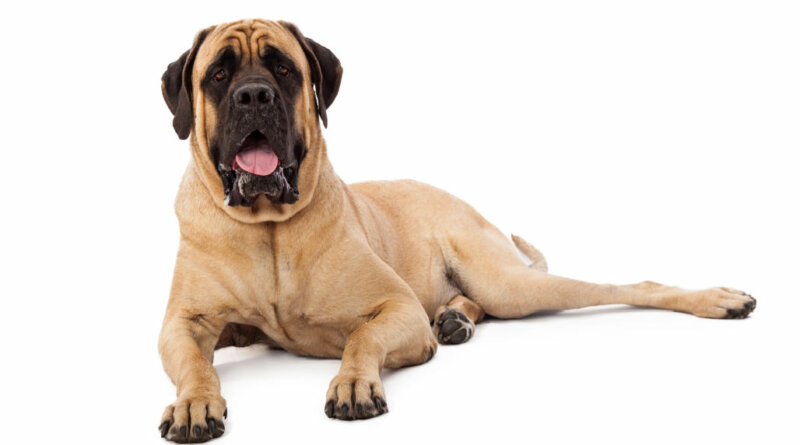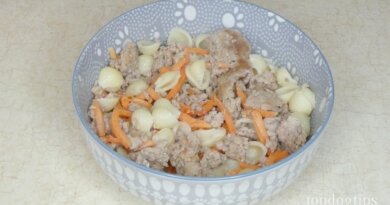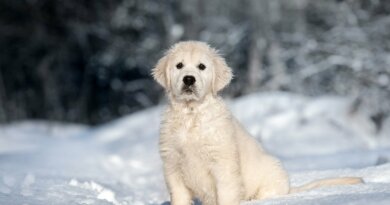Mastiff Dog Breed Profile – Top Dog Tips
The Mastiff. Giant. Regal. Quite intimidating.
Those are only a few words that you’ll probably think of when you come face to face with this giant dog breed.
The Mastiff, or Old English Mastiff for some, is one of the oldest breeds of dogs known to man. It goes way back—originally bred as guard dogs and fighting dogs.
But don’t get scared! Because the modern Mastiff now is as sweet and gentle as it can get.
Below, let’s learn more about the Mastiff’s appearance, characteristics, personality, and short history.
Mastiff Dog Breed: An Overview
According to the American Kennel Club’s breed standard—a Mastiff is a massive, symmetrical dog with a well-knit frame.
They belong to the Working Group category, meaning they are bred to assist men as watchdogs, labor dogs, and even rescue dogs.
A full-grown male Mastiff can grow more than 30 inches in height and weigh up to 230 lbs, while a full-grown female Mastiff can grow more than 27.5 inches and weigh up to 170 lbs.
Mastiff puppies, on the other hand, can weigh from 80 to 110 lbs for males, and 60 to 90 lbs for females at 6 months old.
When taken care of, a Mastiff’s lifespan can reach from 6 to 10 years old.
They are also excellent family dogs. They’re affectionate and excellent playmates for children!
If you don’t mind the drool and have adequate experience in caring for dogs in the past, it may be the perfect time to get a Mastiff.
However, because of their size, you may want to consider your living space. Apartment-dwellers need to think twice before getting a Mastiff, as they will be needing plenty of space to run around.
Mastiff Dog Breed: Short History
Mastiffs have been around for quite some time now, dating back to 3,000 years ago as found in some European and Asian records.
They came from the now-extinct dog breed Molossus, which can be traced back to Ancient Greece about 5,000 years ago.
The name Mastiff itself came from the Latin word mansuetus, which means “tamed” or “domesticated.”
After some time, mansuetus was translated to Old French or Middle English until the term Mastiff was introduced in some English literature in 1387.
Sounds pretty cool, right?
From fighting in battles and getting pitted against lions, bears, and other wild animals in blood games, to guarding livestock against predators, Mastiffs surely have an impressive (and quite intimidating, if you ask me!) history.
Mastiff Dog Breed: Traits and Characteristics
Mastiffs have always been genetically big because of the purpose they served in the past. They are gigantic–no doubt about that!
But apart from the size, another thing that you’ll probably notice immediately is their black mask and their wrinkled foreheads. Their ears are also naturally floppy and their eyes are droopy, making them look kind but still alert.
Their rectangular body is symmetrical; they are heavy-boned with a powerful muscle structure.
The Mastiff’s color ranges from apricot, brindle, or fawn. They also have a short double coat that sheds moderately.
They are also adaptable to changes in living conditions, weather, routine, and possible variations in their day-to-day life.
Mastiffs can tolerate quite a bit of cold weather, but not so much the heat. Just like pugs and bulldogs, they are brachycephalic.
This means that they have short snouts which makes it difficult for them to breathe in certain conditions.
As compared to other large, working dogs, Mastiffs have a moderate energy level. They only have low exercise requirements and can happily be couch potatoes if you allow them.
However, Mastiffs have the potential to gain weight, so it’s advisable to give them adequate physical exercise to keep them fit. Stimulating them mentally can also take their mind off getting too mouthy!
Oh, and you may also want to buy some bib and earplugs. Aside from the drooling, they are quite the snorer too.
And there’s also this thing they do with their behind (a.k.a. fart). Maybe a nose plug is a good idea too, no?
Mastiff Dog Breed: Personality and Temperament
Despite their history, no doubt that Mastiffs are great family dogs. They are very much affectionate with their human family, especially with children. Just watch out for infants and toddlers—Mastiffs may be too big for them!
These gentle giants are watchdogs through and through; they’re very much protective of their families.
They are not much of a barker, but when they do, they are definitely trying to alert you about something.
With enough socialization experience, Mastiffs can also be friendly with other dogs and strangers. If not, they will be aloof and vigilant.
And however polite they may be, they will still jump in front of you to protect you from any danger they may be sensing.
Mastiffs can also be trainable except for moments when they can be too self-willed, but nothing that obedience training can’t fix.
They also sure love some playtime–they’d happily play fetch with you but only until they get tired. You’ll probably end up carrying them home if they over-exert too much!
Mastiff Dog Breed: Care Needs
Grooming needs
Because Mastiffs have short, double-coat, they shed too (but not as much as a Husky, don’t worry!)
They are not as high-maintenance in terms of grooming as other dogs, but at least a weekly brushing is recommended.
Vacuuming and lint-rolling are your best bet in keeping the house clean from their fur, especially during their heavy shedding season twice a year.
Cleaning them off with wet wipes or chamois cloth should also be enough to keep them sparkly clean. Pay extra attention to their ears, eyes, and the deep wrinkles on their forehead.
Brush their teeth at least twice a week to prevent tartar buildup and bad breath.
Also, because they are droolers, always keep a tissue or cloth at bay.
As for their nails, they also need regular trimming just like any other dogs.
Feeding needs
A Mastiff’s meal time should be properly portioned and scheduled. Remember that they are weight-gainers; they’d happily munch away if given the free pass!
Mastiff puppies need to be fed with highly-nutritious meals, especially those that are dense with Protein, Calcium, and Phosphorous. Because they are large breeds, this will help prevent them from getting any bone diseases in the future.
Talk to your vet about the feeding requirement of your dog as their age, size, build, and activity levels also need to be considered to determine their dietary needs.
Mastiff Dog Breed: Potential Health Problems
Just like any other purebreds, Mastiffs are also susceptible to a couple of health problems.
Overheating/ Heat Stroke
As mentioned, Mastiffs are more tolerant of colder weather than hot ones. Because they are flat-nosed, they are more prone to having breathing problems, especially during dog days (pun intended!)
One way how dogs try to cool down is by panting, and a brachycephalic dog like a Mastiff can’t do that quite as well.
Hip Dysplasia
They’re large and big-boned, of course, they’re heavy! Giant dogs like Mastiffs are definitely prone to having bone problems, especially if it runs in their genes.
Hip Dysplasia is generally an inherited disease where the ball and joint in the hips don’t quite fit, causing difficulty in physical activities, and even pain. This can cause arthritis later on, as well as other possible bone complications.
Progressive Retinal Atrophy (PRA)
PRA is a degenerative eye disorder that can cause slow but progressive blindness to your Mastiff in a course of months or years.
This is caused by the loss of photoreceptors at the back of the eye. Unfortunately, there is no known cure yet for PRA.
However, many blind dogs have proven how productive they can still be (thanks to their other highly-sensitive senses!)
Just like Hip Dysplasia, PRA is also hereditary in nature.
Seizures
Mastiffs can also get seizures from a variety of causes, like heat exhaustion, epilepsy, or trauma.
It can be alarming to see a massive dog like a Mastiff suddenly fall into a seizure, but thankfully, this is not painful for them.
With care management, any dog who suffers from a seizure can still have a long and happy life.
Cystinuria
Seen more often in male Mastiffs, Cystinuria is another genetic defect wherein the dog’s kidneys don’t filter Cystine properly, causing it to build up and form bladder stones.
This often causes Urinary Tract infections in our pets and can be life-threatening if not treated right away.
However, not all dogs with Cystinuria form stones but they can still experience several complications because of it.
Gastric Torsion
Gastric Torsion or Bloating may sound too normal. I mean, who doesn’t experience this once in a while, right? But did you know that bloating in dogs can be fatal?
This happens when a dog’s stomach is distended with gas, food, and fluids then twist–not allowing them to release gas and block blood flow to major organs like the heart.
Eating a large meal then drinking large amounts of water, doing heavy exercises before or after a meal, giving food in highly-raised containers, and stress may be some of the causes of gastric torsion.
Cancer
With different varieties of cancers affecting both dogs and humans, Mastiffs can also contract one, especially in their old age.
Luckily, treatment options for cancer are not scarce these days, and there are many inspiring stories of dogs and dog owners who actually survived to tell the tale.
Different Mastiff Dog Breeds
Mastiff is also a popular dog to mix with other breeds, creating many variations over time.
The 4 most common Mastiff breeds are:
Tibetan Mastiff
They are most notable for their rich, lion-like mane. Tibetan Mastiffs are mountain dogs with heavy coats.
This Mastiff breed is intelligent yet has selective hearing.
They are notorious for being strong-willed and too independent. Trust me, you’ll surely need loads of time and patience to train a Tibetan Mastiff.
English Mastiff
English Mastiffs are an easy-going, laidback Mastiff breed, which makes them great family dogs.
Although may not display many emotions and could look quite bored all the time, they are very much loyal and can easily protect you in a moment of danger.
Bullmastiff
A mix between a Bulldog and a Mastiff, the Bullmastiffs are relatively quiet.
Maybe they know they can intimidate intruders with just their size and appearance!
A full-grown male Bullmastiff can average 120 lbs in weight and 26 inches tall in height. They got their round-ish face from the Bulldog but the signature black mask of a Mastiff.
Neopolitan Mastiff
You can easily spot a Neopolitan Mastiff because of their appearance—not only their foreheads are wrinkly but usually some parts of their body too. They are Italian dogs that have a history of guarding estates.
They come in black, blue, mahogany, brindle, or tawny coats, and are also dignified and loyal companions.
Other Mastiff Breeds
There are several other Mastiff breeds all over the world. Some of them are lesser-known, while others are most famously called by a different name. They are:
- Argentinian Mastiff
- Brazilian Mastiff
- French Mastiff aka Dogue de Bordeaux
- German Mastiff aka Great Dane
- Italian Mastiff aka Cane Corso
- Pyrenean Mastiff
- Spanish Mastiff aka Mastin Español
- Canary Mastiff aka Perro de Presa Canario
- Japanese Mastiff aka Tosa Inu/Japanese Fighting Dog
- Alangu Mastiff aka Bulli Kuta
- South African Mastiff aka Boerboel
- Kangal
RELATED: Mastiff Mixes: 10 Different Massive Crossbreeds
Mastiff Dog Breed: Fast Facts
- Mastiffs are one of the older breeds, dating back to 3,000 years ago when they fight as war dogs or guard livestock against predators.
- Mastiffs are the largest dog breed there is in terms of mass.
- Their most notable features are their size, their black mask, and their wrinkled foreheads.
- Don’t overfeed them because Mastiffs are potential weight gainers!
- Mastiffs need physical exercise and mental stimulation, otherwise, they can get bored and destructive.
- They are very loyal and protective of their family.
- Mastiffs are brachycephalic; they can overheat easily.
- They drool, pass gas, and snore when sleeping.
- Mastiffs have a short, double-coat that sheds, but only requires low-maintenance grooming.
- They require obedience training, housebreaking, and socialization at an early age.
Mastiff Dog Breed – Summary
Mastiffs are a great option for people who don’t mind having a giant, lumbering dog in their house.
Because why would you when they can give you equally an huge amount of love with a bonus of drooly kisses on the side?
There are many Mastiff dog breeds with different personalities and temperaments that can suit your and your family’s lifestyle.
READ NEXT: 35 Largest Dog Breeds in the World
Related












reddit canadian pharmacy https://canadianpharm.pro/# canadapharmacyonline com